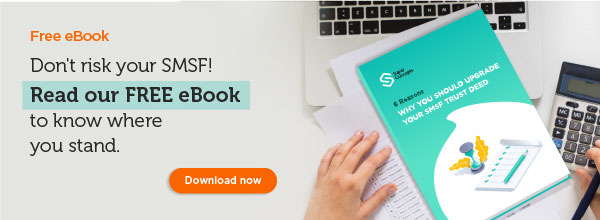
By Graeme Colley
Executive Manager, SMSF Technical & Private Wealth

The lead up to the end of a financial year is an important time to take advantage of the many superannuation changes that have taken place during the year and maximise contributions, review the fund’s performance or receive the right amount of pension from your fund.
This financial year saw the indexation of the contribution caps, the Transfer Balance Cap and Total Superannuation Balance.
We also saw the continuation of the 50% reduction in the minimum amounts for account-based pensions. The good news is that all these changes allow you to keep a little bit more in super.
As part of your planning, you may need to consider the impact of the changes that come into play
from 1 July. If you are between 67 and 75 and you are under your Total Super Balance Cap, you may have the opportunity to make non-concessional contributions without having to meet a work test. Good planning now may reap the rewards over the oncoming years.
With all that in mind, let’s look at the super rules that can work in your favour before this financial year is out.
Contributions
There are two types of contributions that can be made to super, concessional contributions, which are tax-deductible and non-concessional contributions which are not deductible. An employer may claim a tax deduction for any contributions they make for you, and you may be able to claim a tax deduction if you make an election in time telling the trustee of the amount you intend to claim in your personal tax return. The important part is to make sure you contribute to the fund
by 30 June in the financial year, and you send the election to the fund before you lodge your tax return or by the end of the next financial year at the latest.
Personal non-concessional contributions can be made in many situations. For example, you may qualify for downsizer contributions when you sell your primary residence, the small business CGT retirement exemption, make contributions for your spouse, or even a child under 18 years of age. Low-income earners may qualify for the government co-contribution, and low-income superannuation tax offset could also be considered in this category.
Making downsizer contributions has become popular since they commenced in July 2018 and allowed anyone older than 65 to make a non-concessional contribution of up to
$300,000 after selling their main residence.
From 1 July 2022, the qualifying age will be lowered to 60. To qualify for the CGT small business retirement exemption, it is possible for a capital gains tax exemption on the disposal of certain small business assets where the amount will be used for superannuation purposes.
There is no limit to the amount of contributions you can make to super as a concessional or non-concessional contribution. However, there is a catch if your contributions exceed the concessional and non-concessional contributions caps, then a tax penalty may apply to any excess.
The standard concessional contribution of $27,500 for the 2021/22 financial year is taxed in the fund at 15%. Any concessional contributions in excess of this cap are taxed at personal rates. But It is possible to have a higher cap if the amount you had in super on 30 June 2021 was no more than
$500,000. If you qualify, your cap will include the amount that has not been claimed as a tax deduction and is below your concessional contributions cap since 1 July 2018.
A standard cap of $110,000 applies to non-concessional contributions if the total amount you had in superannuation on 30 June 2021, which is called your Total Super Balance, was no more than $1.7 million.
If your Total Super Balance is greater than $1.7 million, a penalty tax applies to your non-concessional contributions, and you may need to withdraw the excess from super. If you leave the excess amount in the fund, it is taxed at 45%.
For anyone under 67
on 1 July 2021, it is possible to access the bring-forward rule, which allows you to bring forward up to the next two years non-concessional contributions. The bring-forward rule applies if your Total Super Balance was no more than
$1.59 million.
If it is between $1.48 million and $1.59 million, then you may qualify to bring forward up to one year’s standard cap, and if you have a Total Super Balance of no more than $1.48 million, then you may qualify to bring forward up to two year’s standard cap.
Salary sacrifice contributions
Salary sacrifice contributions are usually worked out with your employer at the start of a financial year or when commencing a new job. Starting a salary sacrifice agreement prior to the end of a financial year has some issues, as the deduction from your salary may not maximise the amount paid into super.
However, now that personal tax deductions are available for super contributions, you can top up your concessional contributions from personal savings if the amount you have salary sacrificed falls short.
Superannuation guarantee
Don’t forget that Superannuation Guarantee (SG) contributions made by your employer count against your concessional contributions cap of $27,500. As these contributions are compulsory, you will need to account for any amounts made under a salary sacrifice agreement.
Spouse contributions
Spouse contributions can be a critical addition to the superannuation savings of your spouse. As spouse contributions are treated as non-concessional contributions and not tax-deductible, they are counted against your spouse's non-concessional contributions cap. However, suppose your spouse qualifies as a low-income earning spouse, with an adjusted taxable income of less than $37,000. In that case, it is possible for the spouse's contribution to qualify for a tax offset for you as the contributing spouse. If you make a spouse contribution of at least $3,000 then you can qualify for a tax offset of up to $540.
After retirement contributions
There is a special concession for contributions that applies to someone between 67 and 75 years of age in the year after they have ceased working. If you have a Total Super Balance of no more than $300,000 on 30 June in the previous financial year, you can be entitled to make concessional and non-concessional contributions to super without the need to meet the work test this financial year.
With the abolition of the work test for non-concessional contributions from 1 July 2022 this rule will only apply to someone who wishes to claim tax deduction for personal concessional contributions in the year after they have ceased working.
The co-contribution
Don’t forget that if you have made non-concessional contributions of at least $1,000 to superannuation, you may qualify for the government co-contribution of up to $500. To qualify, you must be under age 71, have an adjusted income of less than
$57,016 (2021/22 financial year) and be employed or self-employed.
If you are eligible for the co-contribution, the payment will be automatically paid to your super fund by the ATO once you have lodged your tax return for the financial year.
The low-income superannuation tax offset
The
Low-Income Superannuation Tax Offset (LISTO) of up to $500 depends on the amount of tax-deductible contribution made to super, and your adjusted taxable income is no more than $37,000.
Just like the co-contribution, if you qualify, the ATO automatically pays the amount to your super fund.
CGT small business retirement exemption
Suppose you are a small business owner with net assets of no more than $6 million or a business with a turnover of no more than $2 million. In that case, you may qualify for certain CGT small business retirement concessions on the disposal of the business or certain business assets. The calculation of what qualifies under these concessions is something that your personal tax adviser can help you with. The current CGT threshold amount is
$1,615,000 for the 2021/22 financial year.
There is generally no work test for amounts that qualify under the small business retirement exemption rolled over to super for anyone under age 67. However, once you reach 67, work tests currently apply for the fund to accept the qualifying amount.
From 1 July 2022, the work test is to be abolished; however, it is not possible to make CGT small business retirement amounts after you reach 75.
Keeping an eye on contributions
During the financial year, it helps if you keep an eye on the amount of concessional and non-contributions made to super to see whether any excess is likely to occur and penalties applied. For concessional contributions, it’s essential to see what your employer may have contributed, including anything made under a salary sacrifice agreement. For non-concessional contributions, you should check the amount contributed so far in the 2021/22 financial year and the last two years in case the ‘bring forward rule’ has been triggered. And don’t forget that any spouse contributions you may have made count towards your spouse’s non-concessional contribution cap, which their total superannuation balance can limit.
Making contributions
You can make super contributions in many ways by cash, cheque, electronic transfer or transfer of a limited range of investments. It is crucial to ensure the contribution reaches the fund
by 30 June; otherwise, any late contributions won't until the following year. This could result in an excess contribution, and subsequently, an excess concessional or non-concessional contribution penalty may be applied.
Start an income stream from the fund before 30 June
If you are age 58 (the current preservation age) or older, you are entitled to commence an income stream from 1 June in any year and access the following advantages:
• Any income earned by the superannuation fund on the balance used to commence the pension is tax-free.
• There is no requirement to receive an income stream payment in June of the financial year in which the pension commences. This allows you to delay receipt of the income stream commenced in June 2022 until the end of June 2023.
• If you commence a pension on 1 June 2021 and reach 60 in the next financial year, any pension received after reaching 60 years of age will be tax-free.
Case study
Samantha is 59 years of age and retired. She commences an income stream in June 2022 with $800,000. It is not compulsory for her to receive any income stream before 1 July 2022 unless she chooses. Samantha’s birthday is on 10 May, and if she delays receipt of her income stream until after 10 May 2023, when she reaches 60 years old, the amount she receives will be considered tax free. In addition, any income earned on her balance in the superannuation fund supporting her income stream will also be tax-free from the time it commences in June 2022.
Paying at least the minimum pension or income stream
A critical issue with self-managed superannuation funds is that you must withdraw at least the minimum account-based pension or transition to a retirement income stream from your fund. Don’t forget that for the 2021/22 financial year, the minimum pension percentage has been reduced by 50%.
Underpayment of pensions and income streams can lead to a number of compliance issues if the minimum pension has not been paid. This time of year is good to see whether you will withdraw at least the minimum pension amount from your SMSF by 30 June 2022. This will ensure that the income earned by the fund on any investments supporting the pension will be tax-free and not taxed at 15%.
What the ongoing changes mean
The ongoing changes to superannuation provide some new rules that need to be applied to your situation for the 2021/22 financial year. Whether it’s the concessional and non-concessional contribution caps, tax deductions, or getting pension payments right, they may impact. Make sure you know what’s required to gain the maximum benefit out of your superannuation fund.
Stay connected with SuperConcepts

Wondering whether your SMSF Trust Deed needs an update?

This eBook, written by one of Australia's most trusted SMSF experts, Graeme Colley, uncovers 6 reasons why you should update your trust deed.
To learn more about how our range of SMSF services phone us on 1300 023 170 or request a call back.
Alternatively click through to view our range of services for trustees, accountants and advisers.



